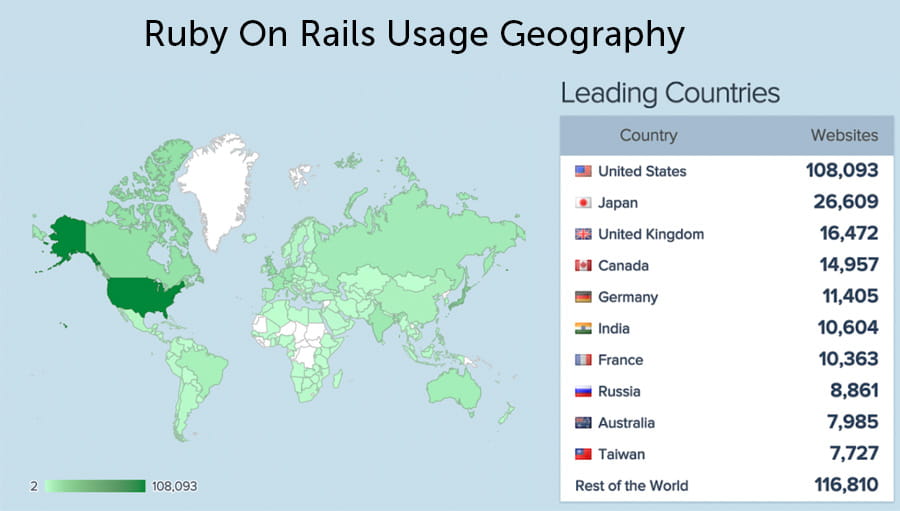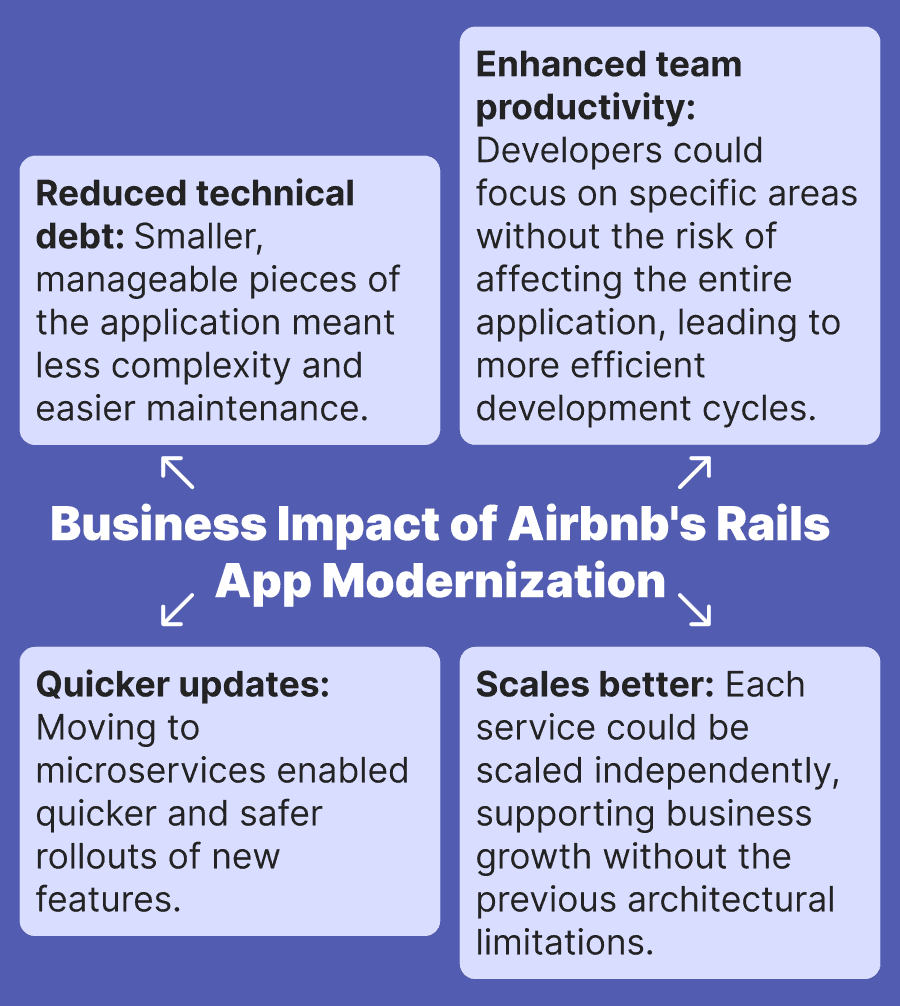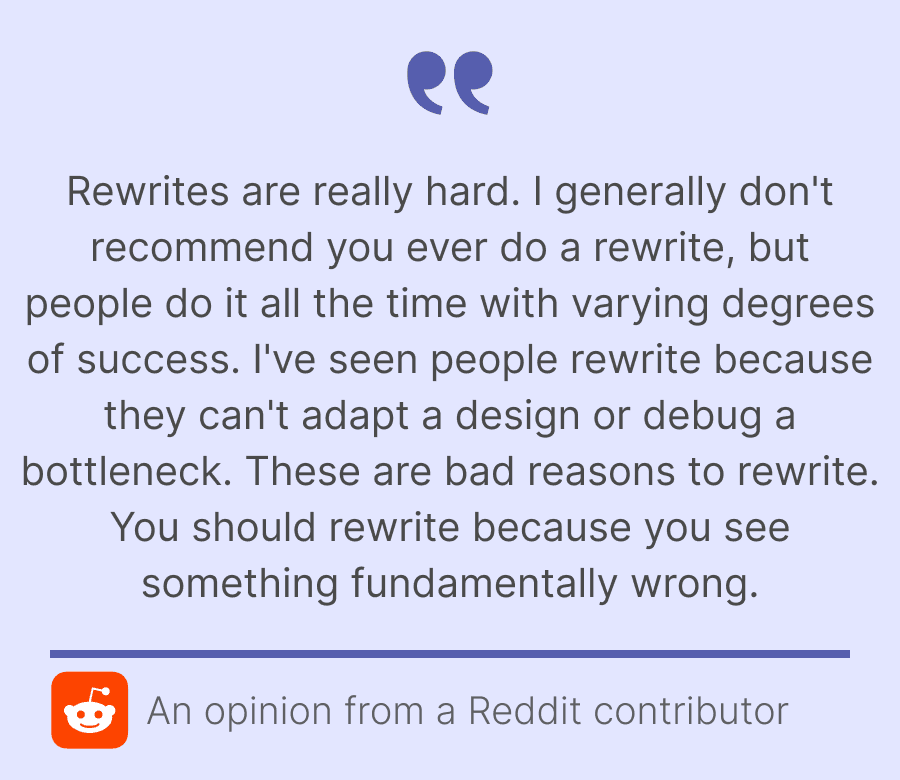Modernizing Your Ruby on Rails App: Tips for Non-Techies

February 26, 2024
Imagine your e-commerce business depends on a Ruby on Rails app. But performance is slow, UI dated, and changes take too long compared to your competitors. You're losing customers.
This article explains Rails modernization in plain language, its benefits, and how to approach it without tech skills.
If you're a non-technical owner of a legacy Rails application, read on. We'll show you how to revitalize your app and enable company growth!
Covered topics:
- Challenges of Rails legacy code
- Benefits of Rails modernization like better performance
- Tips for overseeing modernization without coding skills
Understanding Ruby on Rails
What is Ruby on Rails?
Ruby on Rails is a web application framework written in the Ruby programming language. It allows building database-backed apps fast, following the Model-View-Controller (MVC) framework pattern.
A Rails app has three core components:
- Models - manage data
- Views - handle display
- Controllers - glue between models and views
This Model-View-Controller (MVC) architecture keeps code organized as apps scale.
Think of Rails like the scaffolding around a house. It provides structure and handles mundane coding tasks so developers can focus on app features.
Why Use Rails?
Rails enables rapid web development. Small teams can build robust apps quickly.
Key benefits of using Rails:
- Huge community support
- Code simplicity and readability
- Built-in features like testing and scaffolding
According to the TIOBE Index for February 2024, Rails is the 16th most popular programming language, with a rating of 0.83%. SimilarTech data shows 429,383 websites worldwide use Rails.

Why Modernize Your Ruby on Rails App?
Business Benefits of Modernization
Modernizing your outdated Ruby on Rails application makes sense when it clearly benefits enterprise owners. It's not just about technology; it's about driving your business forward. Below are the key business benefits.
Business Benefit | Description |
|---|---|
Increased Revenue | Modern interfaces and fast, responsive features, thanks to Rails updates, attract more users. This leads to higher engagement, conversion rates, and ultimately, increased sales. Your app can capture a larger market share with a modern Ruby on Rails application. |
Reduced Costs | By updating to the latest Rails version, you can leverage improved performance and scalability. This means you can potentially scale down on expensive infrastructure like servers, thanks to the efficiency of cloud computing solutions (e.g., AWS, Azure). Ruby on Rails also promotes code maintainability, which reduces ongoing development costs. |
Improved Customer Experience | Upgrades bring bug fixes and enhanced features, resulting in fewer crashes and errors. This, combined with a slick, modern interface, significantly improves user experience, fostering increased retention and loyalty. |
Technical Benefits of Modernization
Entrepreneurs also inevitably face the technical challenges of outdated Rails apps, such as security vulnerabilities, scaling issues, and dependency conflicts. Modernization tackles these problems head-on.
- Performance improvements: Upgrading to the latest Rails version boosts app speed and responsiveness. This is crucial for web applications that need to handle increasing traffic as your business or company grows.
- Security enhancements: New versions of Rails include patches for known vulnerabilities, making your application safer against attacks. This is an essential aspect of software development, ensuring the protection of user data and maintaining customer trust.
- Updated features and functionality: With modernization, you gain access to the latest Rails features and improvements. This can significantly enhance the functionality of your web application, making it more competitive and user-friendly.
- Stability and agility: Updated Rails frameworks, databases (e.g., SQL, NoSQL), and other dependencies mean fewer crashes and conflicts. This stability allows your software development team to focus on innovation rather than fixing bugs.
Real-world Example of Successful Rails App Modernization
Airbnb started with a single, large Ruby on Rails application known as the "monorail." As the business expanded, this setup began facing issues. It was hard to make changes or add new features without affecting everything else. Every new feature added more complexity, making it tougher to release updates quickly. This was a big deal for a fast-growing company like Airbnb.
Airbnb's Monolith to Microservices Transition:
To solve this, Airbnb moved from their monolith (the "monorail") to a microservices architecture. This means they broke down the big app into smaller, independent pieces. Each piece, or "service," does one specific thing. Think of it like a team where everyone has their own job, rather than everyone doing a bit of everything.
Outcome:
By modernizing their Rails app, Airbnb improved their business in several ways. They reduced technical debt (less mess in the code to deal with later), sped up their release cycle (getting new features to users faster), and made their software development team happier and more productive. This is a prime example of how updating legacy code can breathe new life into a business, making it ready for future growth.

Approaches to Rails App Modernization
There are three main approaches to modernizing a legacy Rails application.
Incremental Updates: This involves gradually upgrading parts of the app. You fix pain points first while keeping the system running.
- Pros: Less risky and disruptive.
- Cons: Can take longer to fully modernize.
Complete Overhaul: A full rewrite and replatforming of the entire codebase.
- Pros: Faster modernization. Take full advantage of new technologies.
- Cons: Very disruptive. High risk and costs.
Outsourcing: Hire an external team to rebuild or update the app.
- Pros: Leverage specialized expertise.
- Cons: Communication and coordination challenges.

Factors to Consider When Choosing an Approach
Factor | Incremental Updates | Complete Overhaul | Outsourcing |
|---|---|---|---|
Budget | Initially less expensive, with costs spread over time. | Higher initial investment, but potentially more cost-effective long-term. | Cost-effective if the software development partner offers competitive rates and high expertise. |
Timeline | Longer to fully modernize, with ongoing improvements. | Faster overall modernization, despite extensive preparation and transition. | With an efficient process and Ruby on Rails expertise, modernization can be timely. |
RoR App Complexity | Manages complexity in stages, good for code refactoring within Rails. | Best for fundamental flaws requiring a new start, possibly with the latest Rails version. | Suitable for complex projects if the outsourced team is adept at navigating Rails' intricacies. |
Skills and Resources Available | Suitable with an existing Ruby on Rails team, allowing operations while upgrading. | Requires a capable team for a complete rewrite, possibly leveraging new Rails features. | Perfect when specific Rails expertise is lacking in-house. |
Nature of Existing Problems | Effective for addressing specific issues gradually within the Rails framework. | Necessary for overhauling fundamentally flawed web applications. | Best for niche Rails problems or when needing a fresh perspective of external Ruby on Rails experts. |
Future Scalability | Suitable for enterprises planning gradual growth; scalability can be addressed incrementally within the Rails ecosystem. | High scalability potential with a new system designed for growth, leveraging Rails' scalability features. | Ensures the modernized app can grow with the business, with a team knowledgeable in Rails scalability. |
Risk Tolerance | Lower risk of major disruptions, as updates are implemented gradually. | Higher risk due to extensive changes, but manageable with careful planning and testing. | To mitigate risk, partnering with a team experienced in Rails app modernization is key. |
Customer Impact | Minimal immediate impact, as Rails updates are rolled out slowly, ensuring consistent user experience. | Potential for significant short-term impact, but can be mitigated with strategic planning. | The impact relies on the team's mastery in user-centered Rails app updates, planning, and communication. |
Long-term Maintenance | Easier to manage in the short term, but could become complex without proper coordination. | Simplified maintenance post-overhaul with a well-architected Rails system. | A team skilled in Rails best practices ensures smoother transition and maintenance.
|
Technology Alignment | Good for staying aligned with current Rails technology while incrementally adopting new standards. | Allows for full alignment with strategic technology goals, leveraging modern Rails capabilities and integrations. | With a skilled partner, modernization aligns with the company's technology vision. |
Ruby on Rails App Modernization Process
Updating a Ruby on Rails application involves several key steps, each aimed at enhancing the application's functionality, performance, and security. These steps can include:
- Code Refactoring: Improving the code's structure and clarity without changing its external behavior. These code updates enhance maintainability and performance.
- Interface Updates: Revamping the user interface for a more intuitive and engaging user experience.
- Cloud Migration: Optionally moving the application to cloud platforms like AWS or Azure for scalability and reliability, though this depends on the specific needs of the web application.
- Database Optimization: Fine-tuning and cleaning up databases to improve data retrieval and storage efficiency.
- Rails Version Upgrade: Updating the application to the latest Rails version to access new features and security improvements.
- Testing: Rigorous testing is crucial to identify and resolve issues, ensuring the application runs smoothly for all users.
Here’re two particularly important considerations that come to the forefront:
Ensuring Compatibility: It's crucial to make sure the updated application remains compatible with older systems. This prevents disruptions for users on earlier versions and maintains a seamless experience across different application versions.
Comprehensive Testing: Identifying potential issues early through thorough testing is essential. This step ensures a smooth rollout and minimizes the risk of glitches affecting the user experience.
Beyond Modernization
Upgrading your Ruby on Rails application is the first step into a larger world. Your app has the potential to not only adapt but to lead and redefine user expectations. Let’s make your Rails app not just current but pioneering!
- Embrace Continuous Improvement
Think of your app as a living entity that thrives on growth. Ongoing maintenance and updates aren't chores; they're opportunities to enhance performance, security, and user satisfaction. It’s about staying in top shape, ready to meet your users' evolving needs.
- Adopt Emerging Technologies
Rails is your gateway to the future. Integrating AI can transform your app from functional to phenomenal, offering personalized experiences. Cloud computing opens up a world of scalability and resilience, while APIs connect your app to a wider universe of functionalities.
- Future-Proofing Your App Is the New Cool
The tech landscape shifts rapidly. By keeping your Rails app updated and integrating cutting-edge technologies, you're not just keeping pace; you're setting the pace. It’s about staying adaptable and competitive, ready to embrace new trends and user demands with confidence.

Conclusion
The journey of modernizing your Ruby on Rails application is both necessary and rewarding. Continuous improvement isn't just a strategy; it's a commitment to ensure your web app not only meets the current demands but is also poised for future challenges and opportunities.
Taking the first step towards modernization can seem daunting, but you're not alone. Reach out for a consultation with Rails modernization specialists.
With the right resources and guidance, you can begin the process of transforming your app into a more powerful, efficient, and future-ready version of itself.
Further Resources
- Is it better to start from scratch, or upgrade several versions of rails at once? - a discussion on Reddit
- Upgrading Rails: Everyone can do it and here’s how - RailsConf 2022
- A Third Way, or: Updating a Legacy Rails App UI Without Scrapping the Whole Thing - an article on Medium
- Ruby on Rails Statistics and Facts 2024
- What's the best way for a non-technical person to assess the skill level of a Ruby on Rails developer? - a discussion on Quora